
Wine Culture and Information since 2002 - Volume 22
 Wine Culture and Information since 2002 - Volume 22 |
|
Issue 42, June 2006 |
Contents |
|
|
The Rite of Wine |
|
According to a cultural point of view, wine is a beverage full of ritual elements, not only the ones of religious origins, but also the ones determined by society and traditions. Wine has always played an important role in the cultures in which it is present: it can be said the ritual characteristic of wine was born with its “discovery”. Every aspect associated to wine had - and still has - its ritual moments and meanings, something which begins with the harvesting of grapes. For many aspects, harvest represents still today a ritual moment, having very strong social meaning of communion, in which men and women get together and work for the same goal. The social and ritual role of harvesting has been even stronger in past decades - and the same can be said for every other agricultural activity associated to harvests - when friends, relatives and neighbors got together in vineyards for working, an event which always ended with a banquet, made of special dishes which were not generally consumed during the rest of the year. At the end of the day, the same people continued to celebrate the moment of sociality with dances and music, in which wine was always present. Today, besides religious meanings, ritual moments associated to wine and celebrated by every wine lover, have in the opening of the bottle the highest expression. This is evident since the very beginning when the bottle is presented and everyone waits - with a more or less formal ceremony - the removal of cork preceding libation. It is right the extraction of cork to represent the most suggestive moment, the one capable of creating suspense before having the confirmation, for example, the cork is not spoiled by the “unpleasing” corky smell, an event which leaves everyone disappointed and unhappy. Instead - when the cork has been extracted from the bottle and judged to be in good conditions - a smile appears on everyone's face and the ceremony of libation can begin, frequently with a toast as well. It seems to be paradoxical, nevertheless this “delicate” rite depends on a small cylinder of cork, on its extraction and the way it is being extracted, including tools and the technique used in doing it. The rite of the opening of a bottle, as well as of its service, has such an important aspect in wine culture, which have been created for these two aspects vast and rich productions of accessories, from corkscrews to glasses, from foil cutters to disks to be inserted in the bottle in order to avoid inappropriate and accidental “drops”. also corks have been subjected to changes in the course of the last ten years, in fact the almost absolute dominion of cork begins to vacillate. In the last years synthetic corks in different colors have been used to seal bottles, although not always accepted by consumers, indeed, they are frequently considered - unjustly - as the sign of disputable wine quality. In recent times have also been introduced closures made of glass which, just like synthetic corks, avoid the risks of the infamous “corky smell”, the main cause of disappointment in opening a bottle. The introduction of these new closures in the world of wine - including screwcaps and crown caps - has been cause of skepticism for consumers, probably because the classic rituals associated to the opening and service of a bottle of wine have lost, in a sense, some of their dignity. If synthetic corks still allow the ritual ceremony of opening the bottle, by using a more or less technological corkscrew, for glass closures, crown caps and screwcaps, this historical accessory seems to be useless: a simple movement and the bottle is opened, ready to be served. With this kind of closures, apparently, the rite of opening seems to be a useless waste of time, including the “ritual” check of the cork after its extraction in order to make sure it is in good conditions in order to make sure of the absence of the annoying tricloroanisole. With synthetic corks, including screwcaps, crown caps and glass caps, this check seems to be inappropriate, although it is frequently seen - as a matter of custom instead of a real necessity - after the opening of a bottle with a synthetic cork, it is being smelled, the way the ritual would suggest. Is it really necessary to have a ritual in order to appreciate a good wine? Probably not, although according to the natural predilection of humans for traditions, this aspect seems to have a role of primary importance. And what could be said about some producers who decided to sell some of their wines in cans, the same container used for beer of soda pops? With cans, the ritual and ceremony of the opening, as well as service, seems to be seriously compromised. Whether with synthetic corks most of the ritual seems to be saved - excluding the final check of the cork - with the other types of closures, this suggestive moment seems to play a lesser role. Indeed, it is not really lost. Although with wine sold in bottles with crown or glass caps the ritual seems to be simple and immediate, with screwcaps it can however be used a ceremony which can catch the attention of people. In fact, there are many ritual methods used for the opening of a bottle with a screwcap, of course, no one of them make use of a corkscrew or long procedures. The most common, the one which seems to be mainly used and accepted by wine lovers, “borrows” part of the technique from the opening of a sparkling wine. The base of the bottle is held with the right hand, whereas with the left hand it is held the screwcap. At this point the bottle is rotated with the right hand - just like it would be done for a bottle of sparkling wine - in order to unblock the cap and its seal, confirmed by the typical cracking sound. By continuing to hold the bottle with the right hand, the cap is now placed on the left forearm and it is being rolled towards the hand, in order to unscrew the cap which must complete its rolling exactly on the palm of the left hand, therefore leaving the bottle opened. Now the wine can be served, optionally, in case this operation is felt to be important, the cap can be smelled in order to check it is in good condition. Of course, this is a ritual different from the longer and more complex one used for corks, anyway it can be however considered formal. Rites and traditions evolve, change with time and adapt themselves to the new trends of society, and the wine will probably adapt itself too, just like many other aspects associated to the life of humans. After all, how many traditions associated to wine have become obsolete and replaced by other forms, probably more suited to our times? Moreover, are not quality and pleasure of wine which will be poured in glasses to be the most important aspect? Is it useful a suggestive and formal rite without the quality of wine contained in the bottle? These aspects can certainly be neglected, provided the new solutions and technologies always and however ensure a better quality and integrity of wine. Cheers!
|
||||
MailBox |
|
In this column are published our reader's mail. If you have any comment or any
question or just want to express your opinion about wine, send your letters to
our editorial or fill in
the form available at
our site.
|
| I frequently read in order to block the effects of phylloxera, vitis vinifera is grafted on rootstocks of American species. What are these species? |
| Andrew Lewis -- San Diego, California (USA) |
| Because of the reduced thickness of root's bark in the vitis vinifera variety, the effects of the attacks of phylloxera weakens the plant. A stronger rootstock, in particular having a thicker bark, make the attacks of this parasite useless. The species offering a higher resistance to the attacks of phylloxera seem to be vitis riparia, vitis rupestris and vitis berlandieri species, whose rootstocks are usually grafted in young vitis vinifera plants. Moreover, hybrids of European origins are common as well, including the famous AXR 1 - also known as Aramon Rupestris - a hybrid produced with vitis vinifera and vitis rupestris. |
| What is the difference between Riesling and Welschriesling (Riesling Italico)? |
| Annette Klöcker -- Köln (Germany) |
| Despite the name, Welschriesling (Riesling Italico) has no connection with Rhine Riesling, that is the grape simply defined as Riesling. The origins of Welschriesling are not certain, however it is a grape well suited for the climate of central Europe, the area in which it is mainly cultivated. The grape is known with the names Wälschriesling in Austria, Vlassky Riesling in Czech Republic and Slovakia, Olaszriesling in Hungary, Grasevina or Laskriesling in the Balkans and Riesling Italico in Italy. This grape is known for its high yields and for this reason - in case it is not properly cultivated - it tends to make light wines. Cultivated and vinified with quality criteria, Welschriesling make wines with strong aromas of flowers, however completely different from the ones produced with Rhine Riesling. |
Côte d'Or, Côte de Beaune, Côte de NuitsHeart of the enological excellence of Burgundy, Côte d'Or is the indisputable homeland of extraordinary Pinot Noir wines and prestigious Chardonnay wines |
|
If you are thinking about Pinot Noir or Chardonnay, it is therefore impossible not to associate these two grapes with a specific area of Burgundy, with a name full of promise and of good auspice: Côte d'Or. Despite its literally translation is Gold Slope, indeed its name is the abbreviation of Côte d'Orient, that is Eastern Slope. Côte d'Or includes four wine areas, of which the most important and famous ones are Côte de Nuits and Côte de Beaune. Despite these two areas are famous for their Chardonnay and Pinot Noir wines, Côte de Nuits, in the northern part of Côte d'Or, is mainly known for its Pinot Noirs, whereas Côte de Beaune, in the southern part, is mainly known for its Chardonnays, although it should be remembered in this area are produced excellent Pinot Noirs as well. In the Côte d'Or are also defined two other wine areas: Châtillon - north from the Côte de Nuits - and the Hautes-Côtes, defined both for the Beaune and Nuits areas. Côte d'Or, despite its small area covering a narrow strip of territory about 50 kilometers long (about 31 miles), is the most famous wine area of Burgundy and among the most renowned ones of France. The cultivation of vine and the production of wine in these lands is dated back to ancient times. When ancient Romans came to Burgundy in 51 BC, the territory was already occupied by Celts who practiced viticulture and therefore the production of wine. Archaeological researches in these areas suggest the production of wine in Burgundy was practiced since 200 BC. Wine was however an important element even at those times, besides the findings of ancient local wine amphoras, archaeological diggings have allowed the finding of Etruscan amphoras, a sign of the commercial activity of the ancient people from central Italy in these lands. The first written evidences about Burgundian wine are dated back to 312 AD.
Burgundian wine and its quality are mentioned in 591 AD, in a writing of Gregory of Tours who in his “History of Franks”, wrote in the hills west from Dijon were produced such noble wines which could be compared to Falerno, one of the most praised and famous wines at those times. During the dominion of Charlemagne, viticulture and production of wine in Côte d'Or lived high moments of splendor, in particular thanks to the activity of Benedictine monks. Despite the vine was cultivated in every place, the privileged conditions of monasteries, in particular the availability of underground cellars suited for keeping, allowed monks to excel, in a systematic and methodic way, in the production of wine: their contribution in wine making, here as it was everywhere, has been fundamental. The first monks to buy vineyards were the Benedictines of Cluny. With the building of the abbey of Cluny in 910 AD, the monastic order spread in the main European countries, and the interest for vine and wine was always a characteristic that came with them. Thanks to the donations of nobles and well-offs, in 1273 the abbey of Cluny owned all the vineyards around Gevrey. Another abbey who owned famous vineyards was the one of St.-Vivant. In 1232 the duchess of Burgundy gave to this abbey the famous vineyards of Romanée-Conti. La Romanée, La Tâche, Richebourg and Romanée-St-Vivant: vineyards which are still today considered among the most prestigious ones in Côte d'Or. The abbey of St.-Vivant also owned vineyards in Pommard, Auxery and Santenay. Another monastic order which played a fundamental role in viticulture and in the wine making of Burgundy was the one of Cistercians, founded in the city of Cîteaux, not very far from Nuits-St-George. Their first vineyard was acquired in 1098, thanks to the donation of the duke of Burgundy and, despite the order practiced austerity and asceticism, they soon began to acquire vineyards. In 1336 Cistercians owned vast vineyards in the areas of Vougeot, Beaune, Chambolle, Fixin and Pommard. In particular, they built a wall encircling their vineyards at Vougeot, therefore giving origin to the renowned Clos de Vougeot. Thanks to the work of Cistercian monks - done with a scrupulous activity of experimentation and comparison - they finally arrived to the concept of terroir, which is kept in a high consideration by French vintners, as well as the study of the differences among the many crus. Up to the fifteenth century, because of the difficulties of transportation, which in these lands could be done by land only, the most famous wines of Côte d'Or - and of Burgundy - were the ones from the Beaune area. The wines which seemed to be successful were the ones produced in the areas near the rivers: the ease with which they could be transported represented a huge advantage. The notoriety of Côte d'Or and Burgundy wines increased in the twelfth century, when pope Clemente V moved the papal court to Avignon. The request for wines from Beaune - that is wines from Burgundy - increased and with that their prestige as well, and they were soon considered to be “second to nothing”. Another important event which contributed to increase the prestige of the wines from this region, was the predilection the dukes of Burgundy had for them. it is right to this period the first mention of Pinot Noir is dated back, at those times called Noirien. it is more likely, the wines produced at those times in Burgundy were made with Formenteau grape, a variety today considered the ancestor of Pinot Gris. Chardonnay - which is today the most representative and common grape in Burgundy - will enter the wine scene of the region during the Middle Age only. It should be noticed at those times, wines were generally consumed during the first year from harvesting, therefore there was no custom of aging wines. The fame of Côte de Nuits wine was already high in 1728, as it was mentioned in Claude Arnoux's “Dissertation on the situation of Burgundy”, in which are mentioned the rose wines of Volnay, whereas white wines from Côte de Beaune are marginally mentioned. The notoriety of Côte d'Or was stopped in 1878, when in vineyards arrived phylloxera. In 1855, Dr. Lavalle published his “History and statistics of Côte d'Or” in which was included an informal classification of the best vineyards. His work was formalized in 1861 when it was introduced the classification of vineyards in three categories. Finally, in 1930, with the introduction of the Appellation Côntrolée system, the current classification of Burgundy and Côte d'Or wines was introduced.
|
||||||||||||
|
Wines of Côte d'Or, just like the ones of Burgundy, are classified according to the French Appellation Côntrolée system. As opposed to Bordeaux wine region, where quality is defined according to the historical and traditional prestige of the many châteaux, in Burgundy the classification is based on the quality recognized to regions, villages and single vineyards. The lowest level is reserved to regional appellations, such as Bourgogne AC, Beaujolais AC or Chablis AC. The next quality level is reserved to villages, that is reserved to areas inside the territory in communes of specific towns, such as Pommard, Volnay, Gevrey-Chambertin or Meursalt. The two next levels are reserved to the highest quality and are both destined to single vineyards of historical and documented quality. The first one of these two levels is Premier Cru followed by the highest level of quality Grand Cru, reserved to very few vineyards of Burgundy from which traditionally come wines of exceptional quality. Wines belonging to this class have in the label the name of the vineyard and the mention Grand Cru. All the vineyards classified as Grand Cru in Burgundy are found in Côte d'Or and in Chablis. Just like all the other wine classification systems used in other countries, the highest level does not always ensure the best quality and Burgundy makes no exception. Because of historical facts and French laws concerning succession of lands, many of the Grand Cru belong to different owners - each of them owning few hectares - producing very different quality levels. For this reason, it is always good to consider quality in function of the producer instead of the category: in fact, it is not rare to find Premier Cru wines having a superior quality than a Grand Cru. Côte de Nuits villages in which are defined Grand Cru vineyards are: Gevrey-Chambertin, Morey St.-Denis, Chambolle-Musigny, Vougeot, Flagey-Echézeaux and Vosne-Romanée. The ones in Côte de Beaune are defined in the villages of Pernand-Vergelesses, Ladoix-Serrigny, Aloxe-Corton, Puligny-Montrachet and Chassagne-Montrachet.
|
|
The Côte d'Or is located in the northern part of Burgundy, in the outskirts south from Dijon, and covers an area of about 50 kilometers (about 31 miles), reaching the neighboring of Santenay, in a pretty narrow strip of territory. The northern part is defined as Côte de Nuits, from the name of the city of Nuits-St.-George, and in which are almost exclusively produced red wines, whereas the southern part is the Côtes de Beaune, from the name of the city of Beaune, and in which are being produced both white and red wines. The main grapes of Côte d'Or are Chardonnay and Pinot Noir, however in the area are also found Aligoté and Gamay grapes. The soil composition in Côte d'Or is mainly limestone, particularly suited for the cultivation of Chardonnay and Pinot Noir varieties. The areas from which come Premier Cru and Grand Crus wines are all located at altitudes from 250 and 300 meters (820-985 feet), whereas at higher altitudes are being produced lighter wines, generally belonging to village appellation.
|
|
In the Côte de Beaune are produced both white wines, from Chardonnay grapes, and red wines, from Pinot Noir grapes. The area is however famous for its white wines and it is from Côte de Beaune which come the best Chardonnay wines of Burgundy. Hear are in fact found the famous Grand Cru of Montrachet, Bâtard-Montrachet, Bienvenue-Bâtard-Montrachet, Chevalier-Montrachet, Corton-Charlemagne and Criots-Bâtard-Montrachet. Also the red wines of Côte de Beaune are of high quality - in particular the ones from Corton - however they are considered of less value than the ones from Côte de Nuits. As opposed to the red wines from Côte de Nuits, the ones from Côte de Beaune are characterized by a smoother roundness and more “immediate” organoleptic qualities. Among the most famous areas of Côte de Beaune from which are being produced red wines, are mentioned Aloxe-Corton, Beaune, Volnay and Pommard. White wines from Côte de Beaune are characterized by a surprising organoleptic richness and body, with aromas frequently recalling honey, hazelnut, vanilla and - sometimes - truffle.
|
|
Côte de Nuits is indisputably the worldwide homeland of the best Pinot Noir red wines. In this area is also produced a small quantity of white wines from Chardonnay, Pinot Gris and Pinot Blanc grapes. The red wines from Côte de Nuits have a higher structure and organoleptic complexity than the ones from Côte de Beaune and are considered the best Pinot Noirs of Burgundy and of the world. Here are in fact located the famous Grand Cru areas of Bonnes Mares, Le Chambertin, Chambertin Clos-de-Bèze, Clos de La Roche, Clos de Vougeot, Grands Echézeaux, Le Musigny, Richebourg, Romanée-Conti and Lâ Tache. Despite Côte de Nuits is a pretty narrow territory, the diversity of its terroirs is vast and rich. To this are also added the vinification techniques adopted by producers in order to increase body and complexity of their wines, such as, for example, pressing and, in particular, the specific philosophy adopted by every producer for aging. Recently it has been introduced cold maceration of grapes before fermentation, a practice which is followed by many producers which however has strong detractors in the ones supporting a production obeying to the traditional model. Despite these “little” disputes among producers, an aspect which remains indisputable of Côte de Nuits, is that here are being produced the best Pinot Noirs of the world.
|
Comparing Cabernet SauvignonOne of the most common international grapes, cultivated in every wine country of the world and present in countless wines, is the protagonist of this month's comparative tasting |
|
Among the many grapes which from Bordeaux have spread all over the world, Cabernet Sauvignon is one of the most known ones. Protagonist of complex and full bodied wines, Cabernet Sauvignon has easily conquered the vineyards in every country of the world, frequently replacing the traditional local grapes. In many cases, Cabernet Sauvignon has quickly become the most frequent ally for local grapes giving origin to new wines of pretty “international” style. This is the case of Italy, and however very common in other wine countries of the world as well, in which Cabernet Sauvignon is frequently added to the traditional autochthonous grapes, such as Sangiovese, Nero d'Avola and Montepulciano, as to mention some examples. Cabernet Sauvignon is usually added in order to increase body and organoleptic complexity, however it is evident its use is also determined by commercial reasons, just like Merlot, the other famous red grape from Bordeaux. Besides its prestige and its indisputable reputation, Cabernet Sauvignon attracts wine producers also because of its high content in coloring substances, capable of giving wines intense and dark colors, the high content in polyphenols, capable of ensuring a good structure, as well as its pleasing organoleptic qualities, a richness of fruits which can be well matched to the barrique. By following the enological tradition of Bordeaux, Cabernet Sauvignon is used in the world for the production of wines strongly based on the famous model of the French region and which also provides for the use of Merlot and Cabernet Franc - rarely Malbec and Petit Verdot as well - the way it is suggested by the “recipe” better known as Bordeaux blend to which it is added the barrique. Wood factor is in fact a quality which is virtually impossible to divide from Cabernet Sauvignon, not only because of matters of fashion, but also for making “smoother” the astringent tannins of this renowned red grape. Rarely, Cabernet Sauvignon is vinified in inert tanks, such as steel and cement.
|
|
When cultivated and vinified by using quality criteria, Cabernet Sauvignon makes wines with full body and concentration, robust and complex however agreeable and elegant. Characterized by strong aromas of wild berries - in particular black currant and black cherry - Cabernet Sauvignon is a grape which can be perfectly matched to the organoleptic qualities passed from wood during aging. The most common type of cask used for fermenting and aging Cabernet Sauvignon is the barrique - the same used in Bordeaux - rarely large casks. Inert containers, such as steel or cement, are generally excluded from the vinification process of this grape, saved in very rare cases and in specific enological choices also determined by the viticultural characteristic of the grape. The goal of our tasting will be represented by the study of the impact of the wood in the organoleptic qualities of Cabernet Sauvignon, a factor present in the three selected wines.
The three wines selected for our comparative tasting are produced with 100% Cabernet Sauvignon, fermented and aged in barrique and coming from three different areas of Italy. The first selected wine is Castel Schwanburg's Alto Adige Cabernet Sauvignon Castel Schwanburg, aged for 18 months in barrique. The second wine is Boccadigabbia's Akronte, a 100% Cabernet Sauvignon from Marches and aged for about 20 months in barrique. The last wines is Gualdo del Re's Val di Cornia Suvereto Cabernet Sauvignon Federico Primo, produced in Tuscany and aged for about 14 months in barrique. In order to properly enhance the organoleptic qualities of the three wines - both aromatic and gustatory ones - it will be used a service temperature of 18° C (65° F). The comparative tasting will be done by using three ISO glasses, choosing for all the three wines the latest vintages currently commercialized.
|
||||||||
|
Cabernet Sauvignon is a grape rich in coloring substances, therefore its wines will generally have pretty intense and rich colors, with pretty reduced transparency, which sometimes avoid the passage of light. The colors which can be observed in wines produced with Cabernet Sauvignon - also thanks to their excellent longevity - range from purple red, typical during youth, to garnet or brick red, typical in the apex of its aging. However, the color which will be more frequently observed in Cabernet Sauvignon is ruby red, with pretty dark intensities, a color which will also be present after many years of aging. Just like any other red berried grape, the intensity and the concentration of color strongly changes according to the quality of grapes and, last but not the least, to the wine making techniques used in vinification. In wines produced with grapes cultivated with high yields criteria, the color of Cabernet Sauvignon will however show its characteristic ruby red color, although the transparency will be pretty evident. The first wine of which we will examine appearance is Castel Schwanburg's Alto Adige Cabernet Sauvignon. After having poured the wine in the glass, it will be observed the hue and intensity of its color. It will be noticed an intense and brilliant ruby red color, with a pretty reduced transparency. After having tilted the glass over a white surface, it will be observed ruby red nuances. Let's now examine the second wine, Boccadigabbia's Akronte. The color of this Cabernet Sauvignon is intense ruby red and, just like in the previous case, it will be observed a pretty reduced transparency. By tilting the glass, it will be noticed nuances of garnet red. We will now examine the appearance of the last wine, Gualdo del Re's Val di Cornia Suvereto Cabernet Sauvignon Federico Primo. The analogy with the previous wine is pretty evident, the wine has in fact an intense ruby red color and nuances of garnet red, however transparency will be even more reduced than Akronte.
|
|
The aromatic qualities of Cabernet Sauvignon are very rich and pleasing, including the intense aromas of fruits - in particular wild berries - to which are also added tertiary aromas developed during the aging in barrique, the most common wine making technique for this grape. Cabernet Sauvignon, when cultivated in cool climate areas or harvested not perfectly ripe, tends to develop vegetal aromas, the most common being bell pepper and green bell pepper, a characteristic which is also found in Cabernet Franc and, sometimes, in Merlot. Thanks to its capability of long periods of aging, the aromatic development of Cabernet Sauvignon is very interesting. Time in fact gives this grape very complex aromas, such as tobacco, licorice, coffee and cigar box. In Cabernet Sauvignon wines aged in barrique, it can be frequently perceived balsamic aromas of menthol and eucalyptus. Among the most characteristic aromas of fruit found in this grape, are mentioned black currant - the most typical one - black cherry, plum and blueberry. We will begin the olfactory analysis from Castel Schwanburg's Alto Adige Cabernet Sauvignon. By holding the glass in vertical position and without swirling it, we will do the first smell in order to determine opening aromas. It will be perceived intense aromas of plum and black currant - typical qualities in Cabernet Sauvignon - as well as the unmistakable aroma of vanilla, the witness of the 18 months of aging in barrique. After having swirled the glass in order to favor the oxygenation of wine, we will proceed with a second smell which will allow the perception of black cherry, black berry and violet aromas to which will follow aromas of licorice, tobacco, cinnamon, chocolate, nutmeg and a pleasing balsamic sensation recalling eucalyptus. It will be the noticed a pleasing aroma of green bell pepper, a quality which is typical in many Cabernet Sauvignon wines. We will now examine the second wine of our comparative tasting: Boccadigabbia's Akronte. By holding the glass in vertical position and without swirling, we will evaluate opening aromas which will be characterized by black cherry, plum and black currant, typical fruit aromas in Cabernet Sauvignon. The second smell, done after having swirled the glass, will allow the perception of blueberry and violet aromas, as well as vanilla, licorice, tobacco, cocoa and cinnamon. It will also be noticed a pleasing and light aroma of black pepper, whereas balsamic qualities in this wine will be more similar to menthol instead to eucalyptus. It will be noticed a slight and pleasing aroma of lavender and the typical aroma of bell pepper. Let's now evaluate the third wine, Gualdo del Re's Val di Cornia Suvereto Cabernet Sauvignon Federico Primo. Opening aromas offer hints of black cherry, plum and black currant, just like in Boccadigabbia's Akronte. After having swirled the glass, the sequence will be completed with aromas of blueberry, violet, vanilla, tobacco, licorice, cocoa, clover, mace and black pepper, as well as the typical balsamic aroma of eucalyptus.
|
||||
|
Cabernet Sauvignon is a grape whose wines are generally characterized by a good body, most of the times with a robust structure. Thanks to its important content in polyphenols, also responsible for structure, Cabernet Sauvignon wines generally have a pretty high astringency. It should be noticed the intensity of astringency varies according to the quality of grapes, viticultural criteria and wine making techniques, in particular the use of barrique and the level of toasting of wood. Cabernet Sauvignon is a grape which easily integrates with the organoleptic qualities of wood, a factor which usually have a “smoothing” effect on the harsh tannins of this grape. Wines produced with Cabernet Sauvignon are generally characterized by pretty high alcohol volumes - sometimes reaching 14% - a quality which is particularly useful to improve the balance with the richness in tannins and the low acidity. The first wine we will evaluate is Castel Schwanburg's Alto Adige Cabernet Sauvignon. The first sip will be characterized by a pretty evident astringency caused by tannins, however it will not be excessively aggressive also thanks to alcohol and the pleasing smoothness given by aging. Cabernet Sauvignon is a grape with a pretty limited quantity of acid substances: it should in fact be noticed the acidity of this wine is pretty low. The structure will be pretty robust, a quality we would certainly expect from such a wine. The second wine we will evaluate is Boccadigabbia's Akronte. The attack of this wine will be characterized by strong tannins with a full and robust structure, however it should be noticed how the wine is balanced thanks to the contribution of alcohol and roundness. Let's now pass to Gualdo al Re's Val di Cornia Suvereto Cabernet Sauvignon Federico Primo. Also in this case the attack will be pretty astringent with an evident full body, however well balanced both by alcohol and by its pleasing roundness. It should be noticed how in all the three wines can be perceived an excellent correspondence to the nose, in particular the flavors of black currant, plum and black cherry.
|
|
The three wines of our comparative tasting fully express the organoleptic qualities of Cabernet Sauvignon, in particular the robust structure and the astringency of tannins, as well as the typical aromas and flavors of black currant, black cherry and plum. The finish of Castel Schwanburg's Alto Adige Cabernet Sauvignon is persistent and characterized by the typical flavors of plum, black cherry and black currant. Also the finish of Boccadigabbia's Akronte is persistent with evident flavors of black currant, black cherry, plum and blueberry. The finish of the third wine, Gualdo del Re's Val di Cornia Suvereto Cabernet Sauvignon Federico Primo, does not disappoint expectations and confirms an excellent taste-olfactory persistence with intense flavors of black currant, black cherry and plum. In particular, it should be noticed the influence of the aging in barrique on the organoleptic qualities of the three wines: besides giving the typical tertiary and balsamic aromas, the passage in wood smooths the typical harshness of Cabernet Sauvignon's tannins, therefore making the wine smoother and more balanced.
|
Wines of the Month |
|
|
|
Score legend Prices are to be considered as indicative. Prices may vary according to the country or the shop where wines are bought |
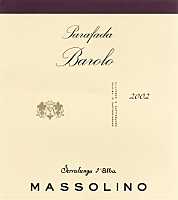
|
|
Barolo Parafada 2002 |
|
| Massolino (Piedmont, Italy) | |
| Grapes: Nebbiolo | |
| Price: € 31.00 | Score: |
| This Barolo shows a brilliant ruby red color and nuances of brick red, moderate transparency. The nose reveals intense, clean, pleasing, refined and elegant aromas which start with hints of cherry, violet and raspberry followed by aromas of plum, blueberry, vanilla, tobacco, cinnamon, licorice, pink pepper, rhubarb, cocoa, leather and menthol. The mouth has good correspondence to the nose, a tannic attack and pleasing crispness, however balanced by alcohol, full body, intense flavors, agreeable. The finish is persistent with flavors of cherry, raspberry and plum. A well made wine. Barolo Parafada ages for 24 months in barrique followed by at least 12 months of aging in bottle. | |
| Food Match: Game, Roasted meat, Stewed and braised meat, Hard cheese | |
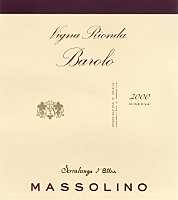
|
|
Barolo Riserva Vigna Rionda Riserva 2000 |
|
| Massolino (Piedmont, Italy) | |
| Grapes: Nebbiolo | |
| Price: € 46.00 | Score: |
| Barolo Riserva Vigna Rionda shows a brilliant ruby red color and nuances of brick red, moderate transparency. The nose reveals intense, clean, pleasing, refined and elegant aromas which start with hints of cherry and violet followed by aromas of blackberry, raspberry, plum, rose, vanilla, tobacco, licorice, cinnamon, cocoa, pink pepper and hints of menthol. The mouth has good correspondence to the nose, a tannic attack and pleasing crispness, however balanced by alcohol, full body, intense flavors, agreeable. The finish is persistent with flavors of cherry, plum and raspberry. A well made wine. This Barolo ages for 36 months in cask followed by 24 months of aging in bottle. | |
| Food Match: Game, Roasted meat, Stewed and braised meat, Hard cheese | |
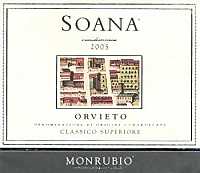
|
|
Orvieto Classico Superiore Soana 2005 |
|
| Cantina Monrubio (Umbria, Italy) | |
| Grapes: Trebbiano Toscano (30%), Grechetto (30%), Verdello (10%), Drupeggio (5%), Malvasia Bianca (5%), Sauvignon Blanc (20%) | |
| Price: € 7.50 | Score: |
| This Orvieto Classico Superiore shows a brilliant greenish yellow color and nuances of greenish yellow, very transparent. The nose reveals intense, clean and pleasing aromas that start with hints of pear, apple and broom followed by aromas of hawthorn, kiwi, plum and peach. The mouth has good correspondence to the nose, a crisp attack and however balanced by alcohol, good body, intense flavors. The finish is persistent with flavors of apple and pear. This wine ages in steel tanks. | |
| Food Match: Pasta and risotto with fish, Sauteed fish, Sauteed white meat | |
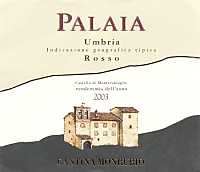
|
|
Palaia 2003 |
|
| Cantina Monrubio (Umbria, Italy) | |
| Grapes: Pinot Noir (34%), Merlot (33%), Cabernet Sauvignon (33%) | |
| Price: € 16.00 | Score: |
| Palaia shows a deep ruby red color and nuances of garnet red, little transparency. The nose reveals intense, clean, pleasing and refined aromas which start with hints of black cherry, plum and black currant followed by aromas of blueberry, violet, vanilla, tobacco, cocoa, leather and hints of eucalyptus. The mouth has good correspondence to the nose, a tannic attack and pleasing roundness, however balanced by alcohol, full body, intense flavors. The finish is persistent with flavors of black cherry, plum and black currant. Palaia ages for 12 months in barrique followed by 12 months of aging in bottle. | |
| Food Match: Roasted meat, Stewed and braised meat, Hard cheese | |
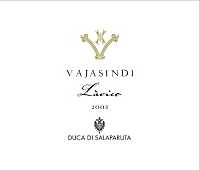
|
|
Vajasindi Làvico 2003 |
|
| Duca di Salaparuta (Sicily, Italia) | |
| Grapes: Nerello Mascalese (90%), Merlot (10%) | |
| Price: € 8.00 | Score: |
| The wine shows a brilliant ruby red color and nuances of brick red, moderate transparency. The nose denotes intense, clean, pleasing and refined aromas which start with hints of cherry, tamarind and vanilla followed by aromas of strawberry, raspberry, plum and cyclamen. The mouth has good correspondence to the nose, a slightly tannic attack and however balanced by alcohol, good body, intense flavors. The finish is persistent with flavors of cherry, raspberry and plum. Vajasindi Làvico ages for 12 months in barrique followed by at least 6 months of aging in bottle. | |
| Food Match: Stuffed pasta with mushrooms, Stewed meat with mushrooms | |
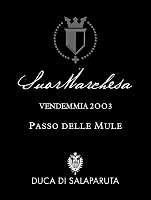
|
|
SuorMarchesa Passo delle Mule 2003 |
|
| Duca di Salaparuta (Sicily, Italia) | |
| Grapes: Nero d'Avola | |
| Price: € 8.50 | Score: |
| This wine shows a brilliant ruby red color and nuances of garnet red, little transparency. The nose denotes intense, clean, pleasing and refined aromas which start with hints of plum and black cherry followed by aromas of blackberry, carob, violet, vanilla, tobacco, mace and menthol. The mouth has good correspondence to the nose, a slightly tannic attack and pleasing roundness, however balanced by alcohol, good body, intense flavors. The finish is persistent with flavors of plum, black cherry and blackberry. Passo delle Mule ages for 10 months in barrique followed by 6-8 months of aging in bottle. | |
| Food Match: Broiled meat and barbecue, Stewed meat with mushrooms, Hard cheese | |
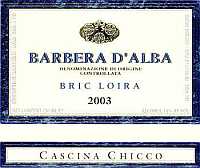
|
|
Barbera d'Alba Bric Loira 2003 |
|
| Cascina Chicco (Piedmont, Italy) | |
| Grapes: Barbera | |
| Price: € 15.00 | Score: |
| The wine shows an intense ruby red color and nuances of purple red, little transparency. The nose reveals intense, clean, pleasing, refined and elegant aromas which start with hints of black cherry, black berry and plum followed by aromas of blueberry, violet, vanilla, tobacco, licorice, cinnamon, cocoa, mace, pink pepper and mint. The mouth has good correspondence to the nose, a tannic attack and however balanced by alcohol, full body, intense flavors, agreeable. The finish is persistent with flavors of blackberry, black cherry and plum. A well made wine. This Barbera ages for 12 months in barrique. | |
| Food Match: Game, Roasted meat, Stewed and braised meat, Hard cheese | |
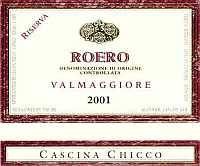
|
|
Roero Superiore Valmaggiore 2001 |
|
| Cascina Chicco (Piedmont, Italy) | |
| Grapes: Nebbiolo | |
| Price: € 15.00 | Score: |
| This Roero shows a brilliant ruby red color and nuances of garnet red, moderate transparency. The nose denotes intense, clean, pleasing, refined and elegant aromas that start with hints of cherry, raspberry and violet followed by aromas of plum, cyclamen, rose, vanilla, tobacco, cocoa, cinnamon, licorice, menthol and hints of leather. The mouth has good correspondence to the nose, a tannic attack and pleasing crispness, however balanced by alcohol, full body, intense flavors. The finish is persistent with flavors of cherry, plum and raspberry. A well made wine. Roero Valmaggiore ages for 24 months in barrique followed by 12 months of aging in bottle. | |
| Food Match: Game, Roasted meat, Braised and stewed meat, Hard cheese | |
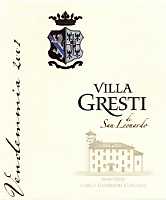
|
|
Villa Gresti 2001 |
|
| Tenuta San Leonardo (Trentino, Italy) | |
| Grapes: Merlot (90%), Carmenère (10%) | |
| Price: € 37.50 | Score: |
| Villa Gresti shows an intense ruby red color and nuances of garnet red, little transparency. The nose reveals intense, clean, pleasing, refined and elegant aromas which start with hints of black currant, black cherry and plum followed by aromas of blueberry, vanilla, violet, tobacco, chocolate, licorice, mace, chocolate and bell pepper. The mouth has good correspondence to the nose, a tannic attack and however balanced by alcohol, full body, intense flavors, agreeable. The finish is persistent with flavors of black currant, plum and black cherry. A well made wine. Villa Gresti ages for about 14 months in barrique followed by at least 12 months of aging in bottle. | |
| Food Match: Game, Roasted meat, Braised and stewed meat, Hard cheese | |
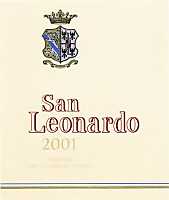
|
|
San Leonardo 2001 |
|
| Tenuta San Leonardo (Trentino, Italy) | |
| Grapes: Cabernet Sauvignon (60%), Cabernet Franc (30%), Merlot (10%) | |
| Price: € 43.00 | Score: |
| San Leonardo shows an intense ruby red color and nuances of garnet red color, little transparency. The nose reveals intense, clean, pleasing, refined and elegant aromas which start with hints of black currant, black cherry and plum followed by aromas of violet, vanilla, tobacco, licorice, chocolate, cigar box, clover, eucalyptus, mace and hints of black pepper. The mouth has very good correspondence to the nose, a tannic attack and however well balanced by alcohol, gull body, intense flavors, very agreeable. The finish is very persistent with long flavors of black currant, black cherry and plum. A great and well made wine. San Leonardo ages for 24 months in barrique followed by at least 12 months of aging in bottle. | |
| Food Match: Game, Roasted meat, Braised and stewed meat, Hard cheese | |
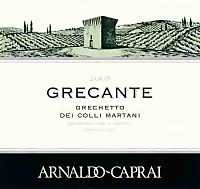
|
|
Grechetto dei Colli Martani Grecante 2005 |
|
| Arnaldo Caprai (Umbria, Italy) | |
| Grapes: Grechetto | |
| Price: € 7.00 | Score: |
| Grecante shows an intense greenish yellow color and nuances of greenish yellow, very transparent. The nose denotes intense, clean, pleasing and refined aromas that start with hints of pear, peach and hazelnut followed by aromas of apple, hawthorn, broom and pineapple. The mouth has good correspondence to the nose, a crisp attack and however balanced by alcohol, good body, intense flavors, agreeable. The finish is persistent with flavors of pear, peach and pineapple. Grecante ages for 3 months in steel tanks followed by 2 months of aging in bottle. | |
| Food Match: Pasta with fish and crustaceans, Sauteed fish, Sauteed white meat | |
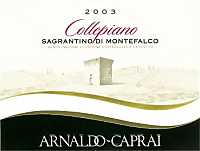
|
|
Sagrantino di Montefalco Collepiano 2003 |
|
| Arnaldo Caprai (Umbria, Italy) | |
| Grapes: Sagrantino | |
| Price: € 27.00 | Score: |
| This Sagrantino di Montefalco shows an intense ruby red color and nuances of garnet red, little transparency. The nose reveals intense, clean, pleasing and refined aromas which start with hints of plum, blackberry and black cherry followed by aromas of violet, blueberry, vanilla, chocolate, licorice, tobacco, mace and coffee. The mouth has good correspondence to the nose, a tannic attack and however balanced by alcohol, full body, intense flavors, agreeable. The finish is very persistent with flavors of blackberry, black cherry and plum. A well made wine. Sagrantino Collepiano ages in barrique for 22 months. | |
| Food Match: Game, Roasted meat, Stewed and braised meat, Hard cheese | |
Guido BerlucchiThe history of Italian spumante passes for Borgonato di Cortefranca, the place where also began the amazing story of Franciacorta and its quality bubbles |
|
The history and the making of great things frequently begins with a dream. And it is right with a dream which begins the history of Franciacorta - today one of the most famous areas for Italian sparkling wines and renowned worldwide - and the wish of challenging a historical myth with what one's own land was capable of offering. The history of Guido Berlucchi, today one of the most successful producers of Italian bubbles, begins around the half of 1950's, when in his cellars they began to create the foundations for the realization of one young winemaker's dream, Franco Ziliani, who wished to challenge the par excellence bubbles - the ones from Champagne - a myth which amazed and made every wine lover dream since centuries. The challenge is however hard and ambitious, because at those times there were no equipments, materials and the fundamental experience in order to make comparisons with a wine and an area having centuries of tradition in the making of wines refermented in bottle - a system today known as Méthode Champenoise - that in Champagne was profitably used since the end of 1600's.
Guido Berlucchi was a countryside gentleman who in the 1950's produced in his cellars - at Borgonato in the province of Brescia - a table wine called “Pinot del Castello”, because the vineyards were cultivated in the slopes of a small hill on the top of which was found the castle of Borgonato. That wine, produced with passion, had however a stability problem, because as soon as it was bottled it used to get hazy. Guido Berlucchi then tried to find the help of a wine maker who could fix the problem, and it was in 1954 he met Franco Ziliani, an enterprising young man full of enthusiasm who had just graduated at “Istituto di Enologia di Alba” (Alba Wine Making Institute). Franco Ziliani fixed Pinot del Castello's stability problem and began expressing to Guido Berlucchi his ambitious dream: the production in Franciacorta of a high quality sparkling wine which could compete with Champagne. At the end of the 1950's, also thanks to the help of Giorgio Lanciani - friend and colleague of Guido berlucchi - they began creating the foundations for sparkling wine production in Franciacorta. It will take many attempts before arriving in 1961 to the creation of the first 3,000 bottles of sparkling wine having the quality Franco Ziliani wanted for that wine. At those times, few people had the opportunity to taste the wine and the few judged that sparkling wine as excellent, impressed both by the quality and elegance of those bubbles. Franco Ziliani decides to call that wine “Pinot di Franciacorta”, a successful intuition since the very beginning: it was the very first time the name Franciacorta was mentioned in a bottle of wine. The success of that wine is striking and Guido Berlucchi began to receive many orders: from those 3,000 bottles, they soon produced 20,000, then 100,000, and finally hundreds of thousands; the myth of Franciacorta had just began. In his dream, now turned into reality, Franco Ziliani wanted to make a sparkling wine having qualities which could be appreciated by anyone and which could be easily found everywhere at a reasonable price.
At the same time, he wished to make profits which could allow him to improve the investments in the cellar in order to continue improving the quality of his sparkling wines. He had no interest in creating an elitist wine destined to few people and sold at high prices. The philosophy of Franco Ziliani was to offer Italians a sparkling wine which could be appreciated for its quality and also having a good value, that is a wine which could keep the name of Italian sparkling wine in high esteem. Today Guido Berlucchi winery is among the most renowned Italian wineries in the world, leader in Italy for the production of classic method sparkling wine, the producer of the most appreciated and looked for bubbles by Italians. The productive philosophy of Guido Berlucchi winery is still today based on these principles. Despite everyone knows Guido Berlucchi winery has been the first cellar making classic method sparkling wines in Franciacorta, this is not however enough in order to ensure a long lasting success. For this reason, the philosophy of Guido Berlucchi has been further strengthened by the conviction it is also necessary to take advantage of the progress made in viticultural and wine making technologies as well as carefully considering the evolution of consumptions. The quality of wines is therefore constantly improved, also working on the renewal and the improvement of the whole wine range. The history of Guido Berlucchi winery is, in this sense, a brilliant example of adaptation and innovation according to times, also adopting the most advanced technologies and their adaptation with the experience gained in the course of more than 40 years in the production of sparkling wines. With these presuppositions, Guido Berlucchi winery has been successful in reaching the ambitious dominant position in the market with its most famous product: Cuvée Imperiale Berlucchi. In the last ten years, Guido Berlucchi winery has faced particularly significative changes which began the renewal and the new course of the winery, the introduction of new quality products, the modernization of technical equipments and the acquisition of new wineries. Guido Berlucchi winery's new generation is today represented by Franco Ziliani's sons - Cristina, Arturo and Paolo - who are getting more and more involved in the life and management of the winery. Guido Berlucchi winery has now a yearly production of about 5,000,000 bottles, and despite of this high number, the quality of the wines is not neglected. Among its famous sparkling wines are mentioned the historical Cuvée Imperiale Berlucchi - available in the styles Brut, Vintage, Max Rosé, Pas Dosé and Brut Extrême - as well as the renowned Cellarius Brut Vintage and Cellarius Rosé Vintage, the latter made for the first time in 2001. Recently, Guido Berlucchi winery decided to start two distinct productive philosophies in order to always give consumers the best quality. The first productive philosophy is about the classic Cuvée Imperiale range, produced with wines coming from the three most famous Italian areas for sparkling wines: Franciacorta, Oltrepò Pavese and Trentino Alto Adige; the second one is exclusively focused on Franciacorta DOCG, represented by Cuvée Storica, a wine capable of expressing the characteristics and qualities of Franciacorta area, the heart of the land where Guido Berlucchi winery was born.
|
||||||||||||||||||||
|
Score legend Prices are to be considered as indicative. Prices may vary according to the country or the shop where wines are bought |
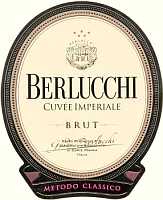
|
|
Cuvée Imperiale Brut |
|
| Guido Berlucchi (Lombardy, Italy) | |
| Grapes: Chardonnay (65%), Pinot Noir (30%), Pinot Blanc (5%) | |
| Price: € 12.00 | Score: |
| The wine shows a brilliant greenish yellow color and nuances of greenish yellow, very transparent, good effervescence, fine and persistent perlage. The nose reveals intense, clean, pleasing and refined aromas that start with hints of banana, pineapple and yeast followed by aromas of bread crust, acacia, hawthorn, pear, apple, hazelnut and grapefruit. The mouth has good correspondence to the nose, an effervescent and crisp attack, however balanced by alcohol, good body, intense flavors. The finish is persistent with flavors of banana, pineapple and apple. Cuvée Imperiale Brut is produced with the classic method and ages in bottle on its lees for at least 18 months. | |
| Food Match: Crustaceans and fish appetizers, Pasta and risotto with fish and crustaceans | |
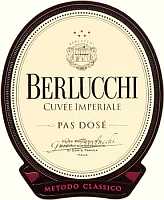
|
|
Cuvée Imperiale Pas Dosé |
|
| Guido Berlucchi (Lombardy, Italy) | |
| Grapes: Chardonnay (65%), Pinot Noir (30%), Pinot Blanc (5%) | |
| Price: € 13.00 | Score: |
| This wine shows a pale straw yellow color and nuances of greenish yellow, very transparent, good effervescence, fine and persistent perlage. The nose denotes intense, clean, pleasing and refined aromas which start with hints of bread crust, yeast and grapefruit followed by aromas of pineapple, banana, hawthorn, mineral, hazelnut, apple and plum. The mouth has good correspondence to the nose, an effervescent and crisp attack, however balanced by alcohol, good body, intense flavors. The finish is persistent with flavors of plum, grapefruit and pineapple. Cuvée Imperiale Pas Dosé is produced with the classic method and ages in bottle on its lees for at least 18 months. | |
| Food Match: Aperitifs, Fish and crustaceans appetizers, Pasta and risotto with fish and crustaceans | |
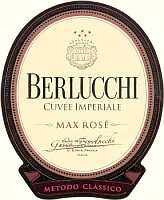
|
|
Cuvée Imperiale Max Rosé |
|
| Guido Berlucchi (Lombardy, Italy) | |
| Grapes: Chardonnay (45%), Pinot Noir (50%), Pinot Blanc (5%) | |
| Price: € 15.00 | Score: |
| This wine shows a pale onion skin color and nuances of onion skin pink, very transparent, good effervescence, fine and persistent perlage. The nose reveals intense, clean, pleasing, refined and elegant aromas that start with hints of raspberry, cherry and strawberry followed by aromas of yeast, bread crust, blueberry, hazelnut, pink grapefruit, apple and plum. The mouth has good correspondence to the nose, an effervescent and crisp attack, however balanced by alcohol, good body, intense flavors, agreeable. The finish is persistent with flavors of raspberry, cherry and plum. Cuvée Imperiale Max Rosé is produced with the classic method and ages in bottle on its lees for at least 18 months. | |
| Food Match: Stuffed pasta, Roasted fish, Broiled crustaceans, Roasted white meat | |
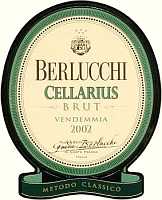
|
|
Cellarius Brut 2002 |
|
| Guido Berlucchi (Lombardy, Italy) | |
| Grapes: Chardonnay (80%), Pinot Noir (15%), Pinot Blanc (5%) | |
| Price: € 19.00 | Score: |
| Cellarius Brut shows an intense greenish yellow color and nuances of greenish yellow, very transparent, good effervescence, fine and persistent perlage. The nose reveals intense, clean, pleasing, refined and elegant aromas which start with hints of citrus fruits, bread crust and grapefruit followed by aromas of banana, yeast, pineapple, acacia, butter, apple, hazelnut and pear. The mouth has good correspondence to the nose, an effervescent and crisp attack, however balanced by alcohol, good body, intense flavors, agreeable. The finish is persistent with flavors of banana, hazelnut and grapefruit. A small part of the base wine is vinified in barrique. Cellarius Brut is produced with the classic method and ages in bottle on its lees for at least 30 months. | |
| Food Match: Pasta and risotto with fish and crustaceans, Stewed and broiled fish, Sauteed white meat | |
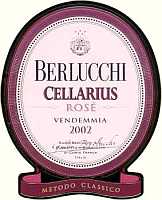
|
|
Cellarius Rosé 2002 |
|
| Guido Berlucchi (Lombardy, Italy) | |
| Grapes: Chardonnay (45%), Pinot Noir (55%) | |
| Price: € 21.00 | Score: |
| Cellarius Rosé shows a pale brilliant pink color and nuances of pale pink, very transparent, good effervescence, fine and persistent perlage. The nose denotes intense, clean, pleasing and refined aromas which start with hints of raspberry, cherry and yeast followed by aromas of arbutus berry, bread crust, banana, pineapple, strawberry, pear and tangerine. The mouth has good correspondence to the nose, an effervescent and crisp attack, however balanced by alcohol, good body, intense flavors, agreeable. The finish is persistent with flavors of raspberry, cherry and pineapple. Cellarius Rosé is produced with the classic method and ages in bottle on its lees for at least 30 months. | |
| Food Match: Cold cuts, Pasta and risotto with meat and vegetables, Broiled fish and crustaceans | |
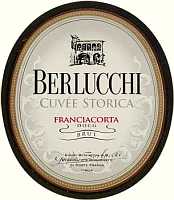
|
|
Franciacorta Brut Cuvée Storica |
|
| Guido Berlucchi (Lombardy, Italy) | |
| Grapes: Chardonnay (95%), Pinot Noir (5%) | |
| Price: € 19.00 | Score: |
| This Franciacorta shows a brilliant greenish yellow color and nuances of greenish yellow, very transparent, good effervescence, fine and persistent perlage. The nose denotes intense, clean, pleasing and refined aromas which start with hints of bread crust, yeast and banana followed by aromas of acacia, citrus fruits, pineapple, plum, mineral, hazelnut and pear. The mouth has good correspondence to the nose, an effervescent and crisp attack, however balanced by alcohol, good body, intense flavors, agreeable. The finish is persistent with flavors of apple, banana and plum. A small part of the Chardonnay and all the Pinot Noir used for the base wine is fermented in barrique. Franciacorta Cuvée Storica ages in bottle on its lees for at least 24 months. | |
| Food Match: Pasta and risotto with fish and meat, Broiled fish, Sauteed white meat | |
| Guido Berlucchi - Piazza Duranti, 4 - 25040, Borgonato, Brescia (Italy) - Tel. +39 30 984381 Fax. +39 30 984293 - Winemaker: Ferdinando dell'Aquila, Arturo Ziliani - Established: 1961 - Production: 5.000.000 bottles - E-Mail: info@berlucchi.it - WEB: www.berlucchi.it |
Cellar Journal |
|
This section is reserved to wine producers who want to publish news and information about their business, to announce new products or just for communicating to customers information and promotions about their products and activity. Send news to be published to our e-mail address.
|
News |
|
In this section are published news and information about events concerning the world of wine and food. Whoever is interested in publishing this kind of information can send us a mail to our address.
|
Chinese Cooking and WineAmong the most ancient culinary arts of the world, Chinese cooking represents a richness in aromas and flavors, frequently based on opposed elements and which can be matched to wine |
|
Besides being considered one of the most ancient civilization of the world, China has also a gastronomic culture and tradition which are considered among the most ancient of humans. Not only an ancient cooking, but also rich and complex, probably among the richest gastronomies of the world. This is also because China has been one of the main protagonists of civilization, a process which allowed the many forms of human expressions to be formed and developed, even in an ordered and methodic way. Chinese cooking represents a very particular gastronomic case, not only based on principles suggested by the taste of ingredients, but also to that very special philosophy - having its origin from the principles of Taoism - making every dish an unique occasion, not only for the palate, but also for the eyes. In China, cooking can be defined as a complete art which is not only limited to the processing and cooking of ingredients, but also to their association according to profound and ancient organoleptic and philosophic principles.
The principles in which Chinese cooking is based on, go beyond these fundamental factors and - as it was easily obvious to happen in a vast country, with a numerous population and with many cultural, philosophical and religious differences - regional influence represents a further element of richness and diversity. Chinese cooking is generally classified in four different styles, according to the four geographic areas which had contributed, more than others, to determine recognizable and specific styles. These differences are particularly recognized by the use and presence of certain ingredients and specific cooking techniques, however most of the ingredients of Chinese cooking are present everywhere in the country and make - as a matter of fact - the foundation of the gastronomic culture in China. Also singular is the way food is consumed, brought to the mouth with the famous chopsticks, which are certainly known by anyone and distinguishing China and its cooking everywhere in the world. Despite the use of chopsticks can be seen as curious, indeed it is an absolutely coherent method with this cooking - made of foods cooked in small pieces, therefore suited for these tools - and the versatility of chopsticks is also very functional in the kitchen for the preparation of recipes.
|
||||||||
|
The richness of Chinese cooking begins from the variety of ingredients used for the preparation of the dishes. It can be said there are few things not used in Chinese cooking, and the presence of ingredients coming from the vegetal, animal and fish world are widely represented in every dish. Because of the vast use of ingredients without prejudices, it is common to say that in China “everything walking, can be used in cooking”, a saying which is also proven by the use of particular ingredients and meats that, for example, would not meet the taste and culture of western people. This is the case of dog meat and the many insects which are considered in China as delicacies instead. On this regard, it is good to reassure our western readers, because in European or American Chinese restaurants, these ingredients are never used - save the case this is explicitly requested - even though they are hardly found outside the borders of China. Foreign Chinese restaurants base - and frequently adapt - their recipes according to the ingredients generally used in the cooking of the country in which they are, or however accepted by local cultures. Despite the richness of ingredients, the ones mainly used for daily cooking are of vegetal origin, including rice, cabbage, bamboo, spaghetti (made of wheat, rice or soy flours), onion, ginger and tasty sauces - of vegetal origin - in particular the famous soy sauce. Among other vegetables of common use in China are mentioned spinach, eggplants, cress, swiss chards, savoy cabbage, turnips, zucchini, pumpkins, carrots, greenbeans and mushrooms, as well as soy and bamboo sprouts - including the ones of other plants - onion, leek and garlic. A fundamental role is played by soybeans, consumed in many forms, and from which are obtained many products, such as toufu and the renowned sauce. Very used are also eggs, seaweeds, seeds - in particular sesame - and rice, mainly used as a side dish for other foods. As in China there are no restrictions of religious, philosophic or spiritual origin, meats used in cooking can virtually come from every animal present in the territory, including reptiles and insects, however the most common meats are the ones of pork and chicken, followed by bovine and ovine meats. In general terms, every part of the animal is used in Chinese cooking: here it can be said absolutely nothing is thrown away.
|
||||
|
In every Chinese meal worth of this name, there must always be a soup. Chinese people have a particular predilection for soups - something which is hard not to agree according the endless richness offered by Chinese cooking - and stock is an essential ingredient found in every kitchen. Before discussing the many techniques used in Chinese cooking, it is appropriate talking about its tools. As opposed to the culinary traditions of other countries - such as Europe - the number of tools present in Chinese kitchens can be defined essential and minimal. Few tools which can be considered highly functional. In Chinese kitchens is generally found one knife only - with a high rectangular blade, similar to the so called cleaver - with which cooks cut every kind of ingredients. Also chopsticks are found in the kitchen - and not only on the table - and are used to turn foods over or to stir or mix ingredients during cooking. Another tool is skimmer, indispensable for frying and dripping ingredients. For the cooking of foods is used the famous wok - the typical hollow Chinese pan and generally of a large size - and bamboo baskets, indispensable for steaming. There are many cooking techniques used in China. Frying is very different from the one done in western countries and there are many frying techniques. The most common method consists in a skilled technique done in the wok and by using chopsticks, or the skimmer, in which the ingredient is plunged in the oil and then quickly raised and rolled in the sides of the wok. Another traditional cooking technique is steaming, consisting in putting water in the wok and to put over it bamboo baskets containing the ingredients to be cooked. In the wok are also done the sauteed and stewing cooking techniques, in the same way they are done in the western world. In China is also used boiling, however, as opposed to western countries, here are not used any sauce or salt: ingredients are simply boiled in water. Among the other techniques are mentioned “bainmarie”, smoking and roasting, particularly used for chicken and duck. In Chinese cooking, foods are also prepared without cooking, by simply mixing cold ingredients together, frequently marinated in wine or vinegar: a technique generally used for vegetables and, sometimes, shellfishes and chicken, preventively cooked and cooled down.
|
|
China is one of the largest countries in the world. Thanks to this, every territory is characterized by its culinary traditions - with typical ingredients, spices, sauces and cooking techniques - however the classification of cooking styles in China is usually divided into four geographic areas. Chinese cooking is mainly recognized in the styles of northern cooking, typical in Peking and Shandong, southern cooking, the most famous style abroad and usually defined as “Cantonese cooking”, south-western cooking, typical in the Sichuan and Yunnan regions, and eastern cooking, the characteristic style in Shanghai and in Zhejiang and Jiangsu regions. The most common style in Chinese restaurant abroad is usually the southern one - the one from Canton - because the first emigrants who started a restaurant in western countries were from this area and therefore their cooking has defined the “model” of Chinese cooking in western countries. The cooking of Peking - also known as “mandarin cooking” - is particularly famous in the world for one of its typical specialties: lacqued duck. The cooking of Peking has its origins from imperial courts, whose cooks were famous for their skill and the care with which they prepared foods. The cooking of Peking is characterized, as opposed to the other styles in China, for the finesse and delicacy of its foods, here the consumption of rice is lesser in favor of wheat, from which are obtained different types of pasta - such as spaghetti, noodles and dumplings - as well as the renowned steamed bread. The most used meats in Peking style are the ones of beef, pork and duck, as well as ovine meat, the latter usually cooked with abundant spices: an evident influence from the neighboring Mongolia. The cooking of Peking is pretty light and cooking is done by using small quantities of fats, dishes are always refined. The cooking of the province of Shandong - very delicate, refined and poor in fats - because of the vicinity with the sea, is rich in fish and here is also made use of fruits and vegetables, as well as traditional soups. Southern cooking, the one typical in Canton, is characterized by the abundance of fish - because of the vicinity with the sea - as well as vegetables and fruits, ingredients always present in the recipes of these areas. Cantonese cooking is also famous for the use of spices, in particular ginger and curry, as well as chili pepper, responsible for the hotness in many recipes. Very common are also sauces, not only soy sauce, but also oyster and prawn sauces. Also meats are present in southern cooking, frequently used together with fish and shellfishes for the preparation of dishes. Another characteristic of Cantonese cooking is the association of meat with dried fruit: famous are the dishes made of chicken and almond, peanuts or cashews. Also fresh fruits are part of the recipes of this region, in association both with fish and with meat, such as in the case of some sweet-sour dishes in which is present pineapple. A typical cooking technique in Canton is the so called “explosive frying”, generally used for vegetables, consisting in dipping foods in a batter and then to shortly fry them in a high temperature oil. A technique with which it is possible to obtain very light and crunchy dishes, although keeping the genuineness of original flavors. Because of the vicinity with India and Tibet, the south-western cooking of Sichuan and Yunnan, is characterized by an abundant use of spices - in particular black pepper, chili pepper and ginger - which generally make dishes very hot. The cooking of these areas is rich in vegetables, fruits and mushrooms, present in huge quantities thanks to the fertility of the soil. Among the main meats is to be mentioned pork, cooked with vegetables - onion and garlic in particular - and spices, as well as Toufu, the typical Chinese “soybean curd”. A Typical method for cooking meat is the frying in boiling lard, therefore seasoned with spices, garlic and onion. Chinese eastern cooking is characterized for the products of the fertile lands and for the fishes of the Yangtze river. Thanks to the fertility of the soil, here the consumption of rice and other vegetables is very high, as well as soybeans, beans and corn. The cooking technique used for meat and fish are usually very slow, allowing the ingredients to cook in their sauces for a long time, typically stewed or boiled. In eastern Chinese cooking - just like in any other area of this country - countless are the recipes of soups.
|
|
Chinese cooking is characterized by a richness of ingredients and traditions, the result of thousands of years of history which can be hardly found in other cooking cultures of the world. Moreover, if we consider the extension of the territory with its typical styles, most of the times different one from another, defining the right matching of wine with this cooking can sometimes be hard, but not impossible. It should be remembered Chinese people do not usually consume wine during meals, the most common beverages found in tables are tea - the national beverage - water and fruit juices, frequently the role of beverage is played by soups or broth. Moreover, the matching with wine is even harder because of the nature of Chinese cooking, frequently being an explosion of flavors in opposition one from another - a principle having its origin from Taoist philosophy - most of the times making a strong contrast, such as in the case of sweet-sour dishes. Also the presence of spices - with their strong aroma and, sometimes, their basically bitter taste - must be carefully evaluated. In these specific cases, also by paying attention to the other ingredients making the dish, very good matching can be done with aromatic and smooth white wines, such as the ones produced with Gewürztraminer. In case the presence of spices is not strong, in dishes having unctuous or fatty sauces, for the matching can be used wines made with Sauvignon Blanc, Viognier and, last but not the least, a crisp and aromatic rose wine. As for red wines, it is particularly suited Pinot Noir, mainly with roasted meat or stewed meat dishes. In this specific case, also wines produced with Sangiovese can be used for the matching, such as Chianti. The countless soups and dishes made of rice and pasta, can be matched with crisp and aromatic white wines, such as Müller-Thurgau, Arneis or Fiano. However it should be remembered the matching with these specific dishes must also be determined according to the other ingredients present in the recipe - vegetables, fish or meat - frequently used together in the same dish. Particular attention must be paid with sweet-sour dishes: in case the sour or acid sensation is dominant, it is better to avoid any matching with wine in favor of a more refreshing green tea.
|
RhubarbA singular plant: the stem is used in cooking and for the preparation of jams and pies, roots are used as a medicine and leaves are toxic |
|
Rhubarb, that is Rheum Officinale (common rhubarb), Rheum Palmatum L. (Chinese rhubarb) belonging to the family of polygonaceae, is a perennial plant with large leaves and small flowers, indigenous of China and of Tibet. The rhizome is used in medicine for its digestive and laxative properties, it is a plant very appreciated by liquor and candies industries. Rhubarb is a very ancient plant, it seems it was cultivated in Asia, more precisely in China, 2,700 years before Christ, where it was used for medical purposes. The first written historical information about the use of rhubarb, according to a therapeutic point of view, were written by Chinese emperor Shen Nung, who lived between 2,700 and 2,800 b.C., in his Pen Tsao Ching - the famous canon of medical herbs - in which are mentioned more than 300 plants, and in which are also described the medical properties of rhubarb.
Ancient Greeks and Romans made a large use of rhubarb, in particular for its officinal qualities. The name “rhubarb” has Greek origins, it is in fact made of the substantive “ra” - the plant - and the adjective “barbaron”, referred to the fact its was cultivated by barbarian people. Many people of the past wrote about rhubarb: Pedanio Dioscoride (Anazarba, first century AD), Greek physician from Cilicia, in modern Turkey, researcher of plant's medical properties; Pliny the Elder, author of the monumental “Naturalis Historia”, in which are discussed matters concerning botanics, medicine and officinal plants, Scribònio Largo, Roman physician, author of many medical studies, was one of the first Latin writers of medical subjects, and in his work “Compositiones Medicamentorum” he collected remedies for many diseases. Everyone knew, used and studied the properties of rhubarb although ignoring its botanic origin. Another important witness is found in the famous Marco Polo's book “The Million”, where he wrote «in the province of Tangue… and in all of its mountains can be found huge quantities rhubarb, and here it is bought by merchants who sell it all over the world…This witness is very important because, despite rhubarb was known and used as a medicine since the times of ancient Greeks and Romans, this confirms at those times its origin was unknown. Despite the many attempts done in identifying the plant, rhubarb was identified in one of the most important medical studies, when the Societé de l'Acclimatation of Paris which obtained, thanks to the French consulate in Tibet, some small plants, which were then cultivated in a greenhouse. Thanks to this, French botanist Baillon could carefully examine the plant and named it as Rheum Officinale. The name derives from the ancient Russian word Rha, that is, root.
|
||||||||
|
Rhubarb is a perennial herbaceous plant with an underground rhizome from which originate many and big roots. From the rhizome originate many clumps of leaves and stems, which can also reach the height of 2-3 meters (6.5-10 feet). The big reddish stems - rich of juice - have the same medical properties of the rhizome, but are mainly used in cooking and for the preparation of jams or candied fruits. The leaves originates from the base and flowers are grouped in a big panicle. The fruit is a brown hanging achene of trigone shape, having three sides. Rhubarb is an indigenous plant of Asia, more precisely of northern-western China, in the mountains near Kuku-nor lake. It is also cultivated in tempered areas of Europe where it requires a light soil, however the best quality rhubarb is undoubtedly the one coming from China. Rhubarb is a plant which does not require lots of care, however it does not stand to drought, therefore it is important to ensure plenty of water. Whoever wants to cultivate some rhubarb plants in his or her garden, should remember its cultivation is pretty simple, as the plant has a good adaptation to different climates and soil types. It is not advised to begin with seeding, as during the first two years, the growth is very slow and during this period stems cannot be harvested, it is then advised to buy small plants in a shop or use sprouts cut from another plant. In case it is wished to use sprouts, they must be planted in autumn, or at the beginning of springtime, in a fertile and humid soil. Rhubarb plants have a good adaptation to shadow, and in autumn it is good to help them with an appropriate fertilization. By following these simple rules, it will be possible to cultivate a perennial plant, which can be grown, in the same place, also for many years.
|
|
In cooking it is common adding some pieces of rhubarb's stems to strawberries during the preparation of jam, in order to exalt and balance taste, which would however be too sweet. The stalks of the leaves can be used for the preparation of jams, harvested in springtime while throwing away leaves which are rich in oxalic acid. In the East, during springtime, are being harvested the first young leaves which are consumed boiled. It should be remembered the edible parts of the plant are the stems; they must be pulpy and the leaves must be pulpy as well. The stem must have a brilliant green color or intense pink, whereas the border of the leaves must be carmine. Rhubarb leaves are not edible. Rhubarb is useful in the garden too. Burying some pieces of rhubarb in the area where are being cultivated cabbages or savoy cabbages, is a natural way to keep away a parasite, Plasmodiophora brassicae, responsible for an extremely dangerous disease for these plants. Rhubarb can also be used in cosmetics as a hair-dye. Allow some pieces of rhubarb to macerate for a week in white wine, filter and use it in wet hair. This dye gives hair copper nuances. In the East, the coloring properties of rhubarb are used for coloring fabrics in a natural way. According to a healthy point of view, rhubarb is used for preparing a tonic tisane for liver. Prepare an infusion with 100 grams of boiling water, 6 grams of dried and powdered rhubarb stems and roots, as well as 2 grams of sodium bicarbonate. Stir well and allow the infusion to cool down, filter and add cold water until having one liter of liquid. Two spoons before meals invigorate liver and are a good remedy for the lack of appetite. It is also used as a digestive because it stimulate the secretion of gastric juices and bile. The main therapeutic property of rhubarb is laxative, however it is a good remedy for hyperlipidaemia and hyperglycaemia. The laxative effect is obtained at high doses, that is with 1 or 2 grams, thanks to the presence of particular glucosides, which - when arrive in the colon - determine a reduced absorption of liquids, which then accumulate in the bowl creating a laxative effect. By taking from 0.05 grams to 0.2 grams, the laxative effect is reversed: at these doses prevail tannins and therefore the laxative effect becomes an astringent effect. The prolonged use of rhubarb as a laxative can cause constipation. Rhubarb is contraindicated during pregnancy and suckling, in case of inflammations of the digestive system, anyone suffering of constipation, hemorrhoids and anyone suffering of blood circulation problems. It is also contraindicated to children below 12. Despite its therapeutic properties, it is however good to be cautious in its use. It is in fact known the interaction of rhubarb with some medicines for the treatment of heart problems. It is therefore a plant to be used only after having asked a doctor. According to a nutritional point of view, rhubarb gives few calories, however it is very acid and it is then good to avoid any contact with aluminum, therefore it is good to avoid the contact with aluminum pans, spoons or foils.
|
||||
AquavitaeReview of Grappa, Distillates and Brandy |
|
|
| Distillates are rated according to DiWineTaste's evaluation method. Please see score legend in the "Wines of the Month" section. |
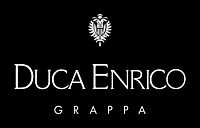
|
|
Grappa Duca Enrico |
|
| Duca di Salaparuta (Sicily, Italy) | |
| (Distiller: Distilleria Trapas) | |
| Raw matter: Pomace of Nero d'Avola | |
| Price: € 32.10 - 50cl | Score: |
| This grappa shows a pale straw yellow color, limpid and crystalline. The nose denotes intense and pleasing aromas of vanilla, licorice, plum and honey with perceptible alcohol pungency. In the mouth is round with intense flavors, perceptible alcohol pungency which tends to dissolve rapidly, balanced sweetness, intense flavors. The finish is persistent with flavors of licorice and honey. This grappa is distilled with discontinuous steam operated alembic still and ages in barrique. Alcohol 40%. | |
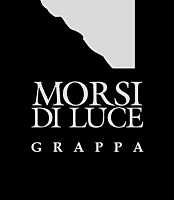
|
|
Grappa Morsi di Luce |
|
| Florio (Sicily, Italy) | |
| (Distiller: Distilleria Trapas) | |
| Raw matter: Pomace of Zibibbo | |
| Price: € 22.10 - 50cl | Score: |
| This grappa shows a pale greenish yellow color, limpid and crystalline. The nose reveals intense and pleasing aromas of raisin, honey, vanilla and hazelnut with perceptible alcohol pungency. In the mouth is round with intense flavors, perceptible alcohol pungency which tends to dissolve rapidly, balanced sweetness, intense flavors. The finish is persistent with flavors of raisin and honey. This grappa is distilled with discontinuous steam operated alembic still. Alcohol 40%. | |
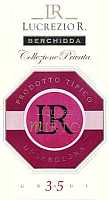
|
|
Liquore di Mirto Collezione Privata |
|
| Lucrezio R. (Sardinia, Italy) | |
| Raw matter: Myrtle Berries | |
| Price: € 15.00 - 50cl | Score: |
| This liquor shows an intense brick red color, transparent. The nose denotes intense, clean, pleasing and refined aromas of myrtle with almost imperceptible alcohol pungency. In the mouth has intense flavors with perceptible alcohol pungency which tends to dissolve rapidly, balanced sweetness, intense flavor of myrtle. The finish is persistent with flavor of myrtle. Produced by the maceration of myrtle berries for 2 months. Alcohol 35% | |

|
|
Acquavite di Uve di Sardegna Selezione Speciale |
|
| Lucrezio R. (Sardini, Italy) | |
| Raw matter: Grapes from Sardinia | |
| Price: € 25.00 - 50cl | Score: |
| This distillate is colorless, limpid and crystalline. The nose reveals intense, clean, pleasing and refined aromas of fennel, apple, hazelnut, elder and medlar, with almost imperceptible alcohol pungency. In the mouth has good roundness and intense flavors, with perceptible alcohol pungency which tends to dissolve rapidly, balanced sweet hint, intense flavors, agreeable. The finish is persistent with flavors of fennel, apple and elder. This distillate is produced with a bainmarie alembic still. Alcohol 40%. | |
Wine Parade |
|
|
| The best 15 wines according to DiWineTaste's readers. To express your best three wines send us an E-mail or fill in the form available at our WEB site. |
| Rank | Wine, Producer | |
|---|---|---|
| 1 |
| Colli Orientali del Friuli Rosazzo Bianco Terre Alte 2002, Livio Felluga (Italy) |
| 2 |
| Riesling Central Otago 2004, Felton Road (New Zealand) |
| 3 |
| Brunello di Montalcino 1999, Castello Banfi (Italy) |
| 4 |
| Trento Talento Brut Riserva Methius 1998, Dorigati (Italy) |
| 5 |
| Amarone della Valpolicella Classico 2000, Zenato (Italy) |
| 6 |
| Wine Obsession 2001, Vignamaggio (Italy) |
| 7 |
| Amarone della Valpolicella Classico 1998, Santa Sofia (Italy) |
| 8 |
| Notarpanaro 1999, Taurino (Italy) |
| 9 |
| Chianti Classico Riserva Novecento 2000, Dievole (Italy) |
| 10 |
| Aglianico del Vulture La Firma 2002, Cantine del Notaio (Italy) |
| 11 |
| Nero al Tondo 2001, Ruffino (Italy) |
| 12 |
| Palazzo della Torre 2000, Allegrini (Italy) |
| 13 |
| Chianti Classico Riserva Novecento 2000, Dievole (Italy) |
| 14 |
| Don Antonio 2003, Morgante (Italy) |
| 15 |
| Montepulciano d'Abruzzo Riparosso 2001, Illuminati (Italy) |
| |||||||
Privacy Policy | |||||||


| Copyright © 2002-2024 Antonello Biancalana, DiWineTaste - All rights reserved |
| All rights reserved under international copyright conventions. No part of this publication and of this WEB site may be
reproduced or utilized in any form or by any means, electronic or mechanical, without permission in writing from DiWineTaste. |